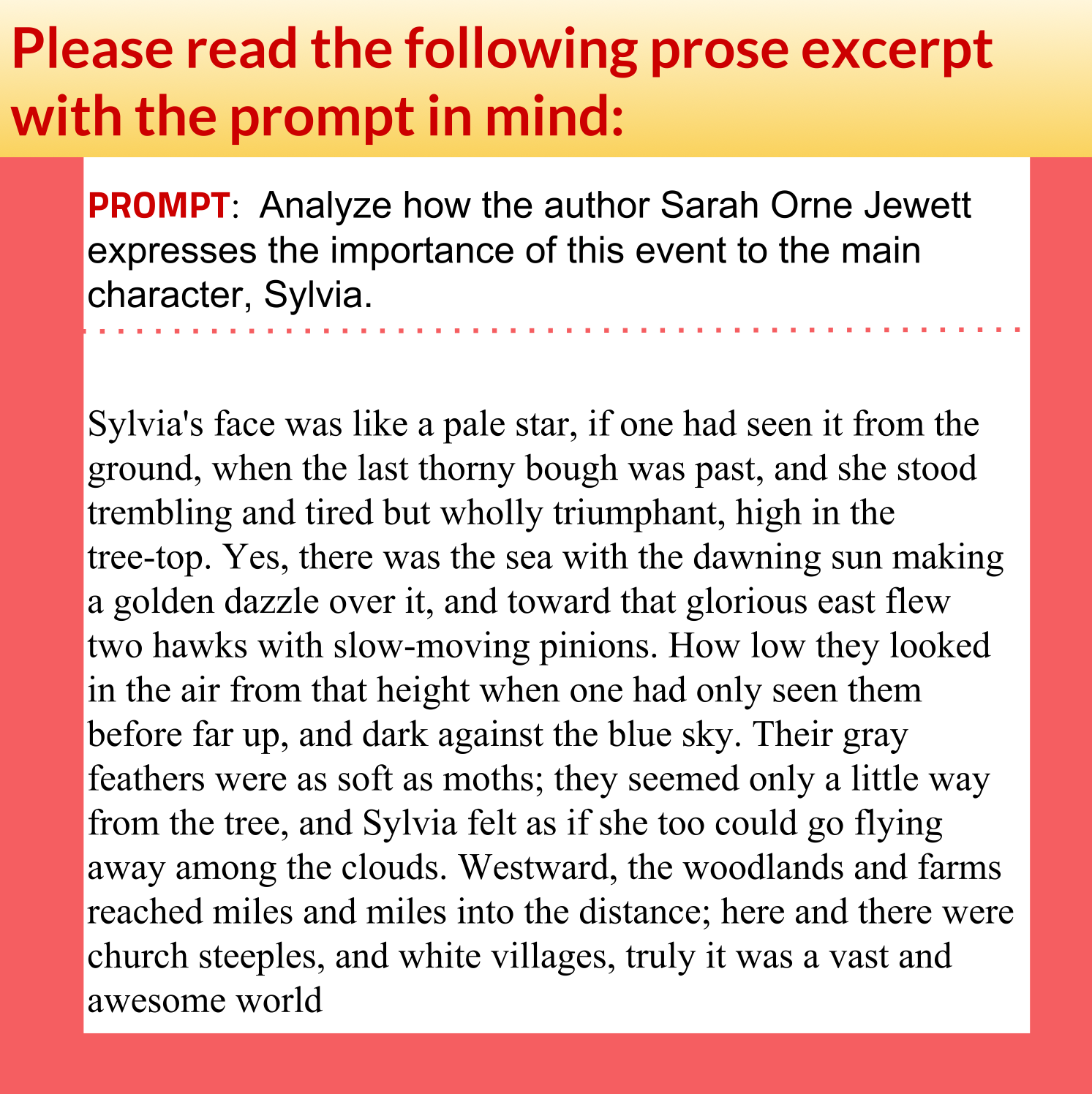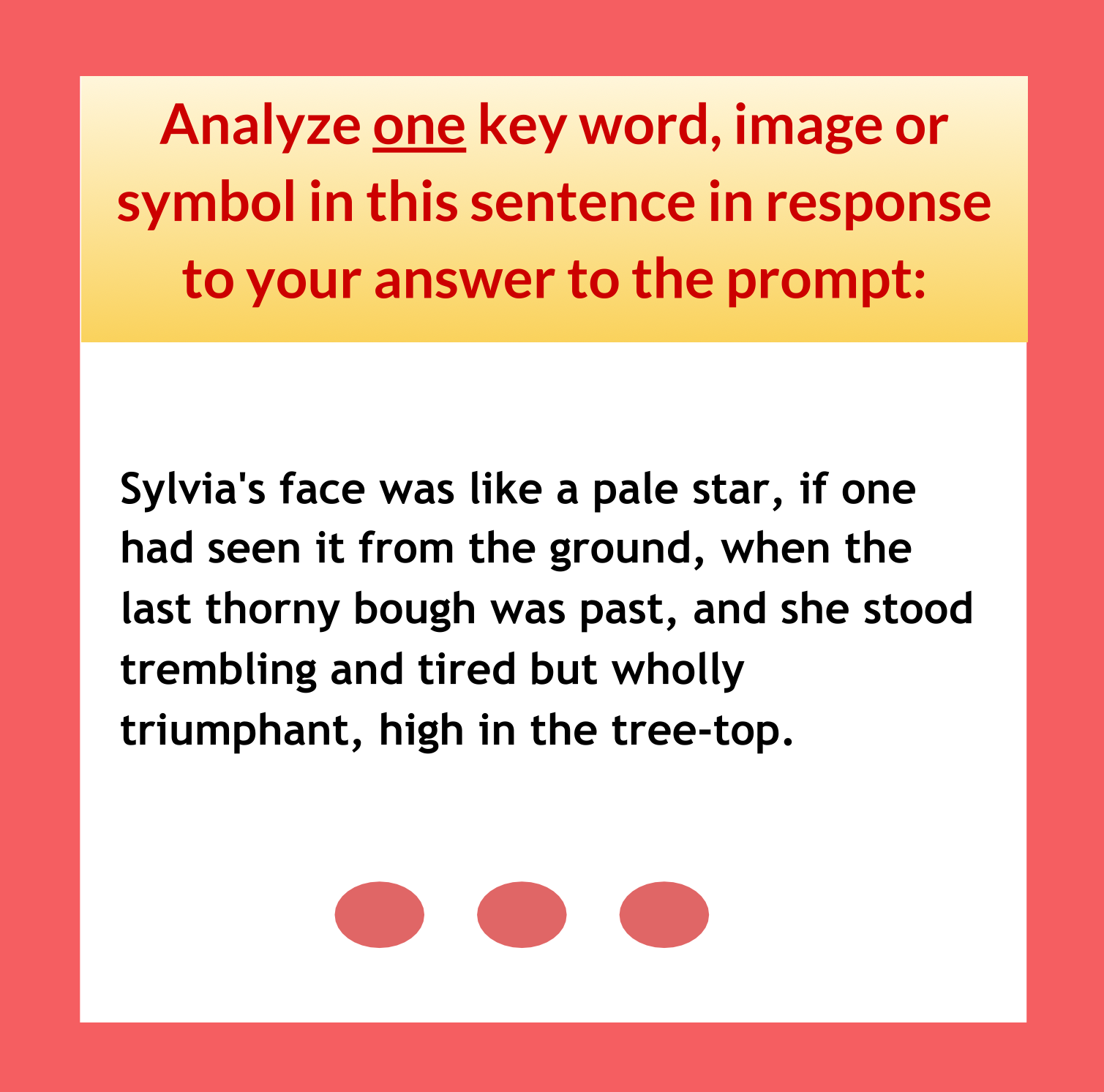Full Textual Analysis Lesson with Growth Self-Assessment
By Amy Buckley
starstarstarstarstar
Last updated almost 4 years ago
16 Questions
Note from the author:
Advanced textual analysis lesson.
Instructions:
This guided analytical lesson is meant to help you master close and critical reading of a smaller literary text like a poem or prose passage.
After completing the practices, your end goals are:
(1) Articulate what it means to analyze and evaluate any subject matter.
(2) Analyze and evaluate with mastery a new reading passage

PART ONE: Warm-Up

Write your "working thesis" for the Sarah Orne Jewett passage prompt--a ONE sentence thesis.
Write your "working thesis" for the Sarah Orne Jewett passage prompt--a ONE sentence thesis.

You may analyze a pair of words if they have to stay together contextually. Please write your analysis here:
You may analyze a pair of words if they have to stay together contextually. Please write your analysis here:

PART TWO: DIRECT INSTRUCTION
PART THREE: Guided Practice
REMINDER: to analyze means to explain the meaning of a word, image, or symbol so you can then comment on the possible connotations and implications as it ties to your argument. Analysis provides you with new insight into the nuances of the language. It is not paraphrasing!

Directions: Read and analytically annotate the paper copy that you have of "A Red Dress," then respond to the following questions.
List, draw, sketch or diagram, the basic situation of this excerpt: setting, speaker/narrator, character(s), and conflict(s).
List, draw, sketch or diagram, the basic situation of this excerpt: setting, speaker/narrator, character(s), and conflict(s).
NOTE: The title and the first and last sentences of literature are extremely important when analyzing the text.
Please analyze how the title and first and last sentences work together to help you more accurately and insightfully craft an interpretive analytical argument for this passage.
Please analyze how the title and first and last sentences work together to help you more accurately and insightfully craft an interpretive analytical argument for this passage.
Too many students read this excerpt literally instead of critically reading (questioning) and analyzing the words, images, and symbolism to understand the nuances of the text.
Based off of your analytical annotations, check of any of the following topics or elements that you analyzed (check all that apply):
Too many students read this excerpt literally instead of critically reading (questioning) and analyzing the words, images, and symbolism to understand the nuances of the text.
Based off of your analytical annotations, check of any of the following topics or elements that you analyzed (check all that apply):
Choose two options from #5's list that you did not analyze.
Analyze each choice and let your analysis of the words, images, or symbols reveal insight
Choose two options from #5's list that you did not analyze.
Analyze each choice and let your analysis of the words, images, or symbols reveal insight

If you read this passage literally, you would not have recognized the irony.
Closely and critically read this paragraph again and analyze why Munro would use dramatic irony in this smaller contrasting second paragraph.
If you read this passage literally, you would not have recognized the irony.
Closely and critically read this paragraph again and analyze why Munro would use dramatic irony in this smaller contrasting second paragraph.
How does this new analysis of dramatic irony change your original understanding or interpretation of this excerpt?
How does this new analysis of dramatic irony change your original understanding or interpretation of this excerpt?
What was in your initial annotations regarding what Lonnie was watching?
What was in your initial annotations regarding what Lonnie was watching?
A lot of readers agree with the narrator's assumption that Lonnie is judging her mother, but the sentence is open-ended.
Make a list of all of the possible observations that Lonnie could be making by sitting on the couch watching mother and daughter. Explain your reasoning (your list shouldn't be all literal observation).
A lot of readers agree with the narrator's assumption that Lonnie is judging her mother, but the sentence is open-ended.
Make a list of all of the possible observations that Lonnie could be making by sitting on the couch watching mother and daughter. Explain your reasoning (your list shouldn't be all literal observation).
What could the physical descriptions of the narrator's mother symbolize? Think of as many answers as you can and analyze how these symbols could add further insight into this passage.
What could the physical descriptions of the narrator's mother symbolize? Think of as many answers as you can and analyze how these symbols could add further insight into this passage.

PART FOUR Self-Reflection & Self-Assessment

Choose one analytical response to self-assess, and show your work on the white board.
Use the questions on the left to guide your self-reflection and self-assessment.
Choose one analytical response to self-assess, and show your work on the white board.
Use the questions on the left to guide your self-reflection and self-assessment.
Choose a second analytical response to self-assess, and show your work on the white board.
Use the questions to guide your self-reflection and self-assessment.
Choose a second analytical response to self-assess, and show your work on the white board.
Use the questions to guide your self-reflection and self-assessment.
Choose a third analytical response to self-assess, and show your work on the white board.
Use the questions to guide your self-reflection and self-assessment.
Choose a third analytical response to self-assess, and show your work on the white board.
Use the questions to guide your self-reflection and self-assessment.
What does it mean to analyze?
What does it mean to analyze?
Are you ready to demonstrate correct and insightful analysis of a text by taking a new test with a new passage?
Are you ready to demonstrate correct and insightful analysis of a text by taking a new test with a new passage?

